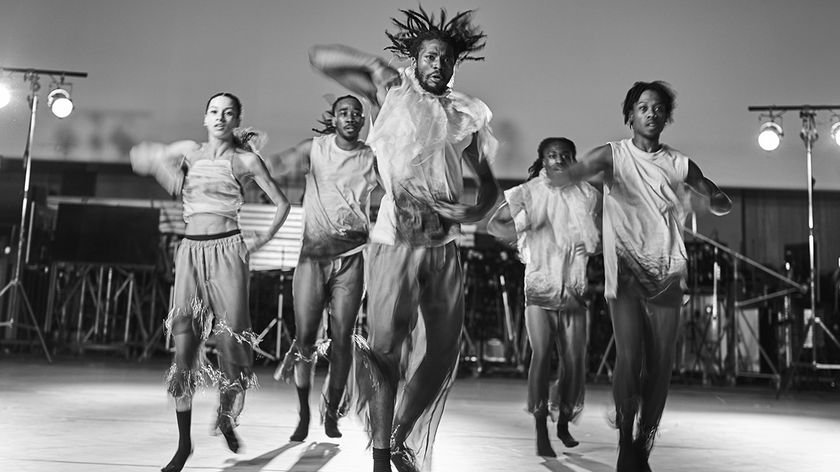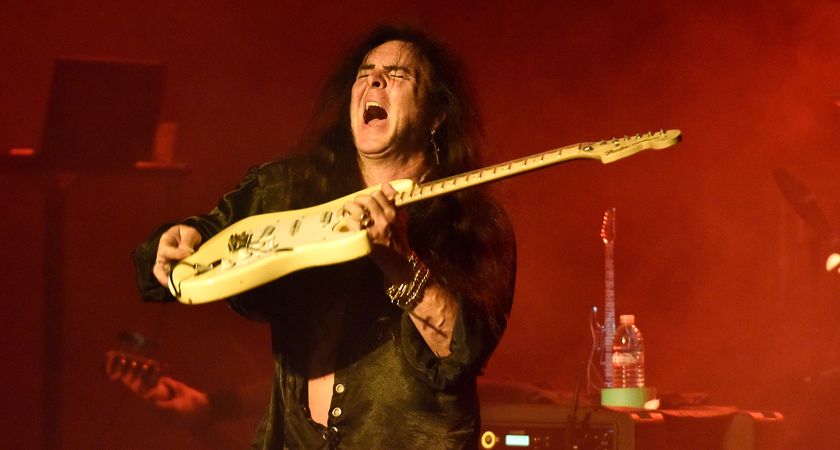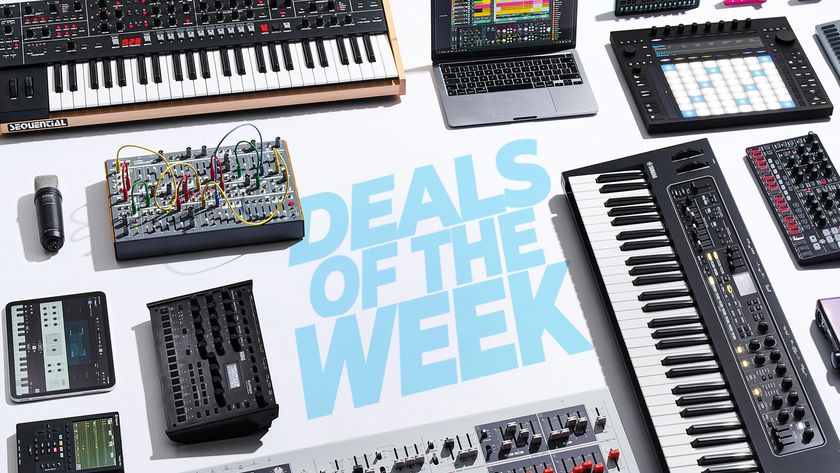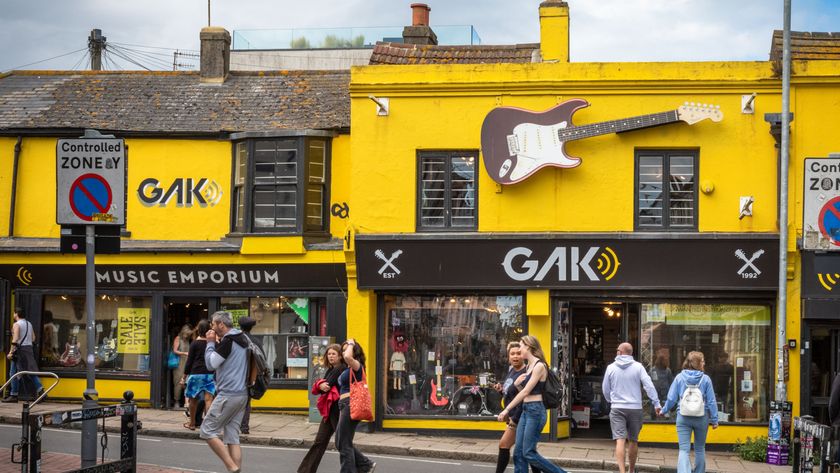Yelle: "Once we have a good song, then I can start worrying about the details"
Jean-Francois Perrier tells us how the French act came to top charts on both sides of ‘le pond’ , how napping is key to any workflow, and shares some timeless advice from Phillipe Zdar
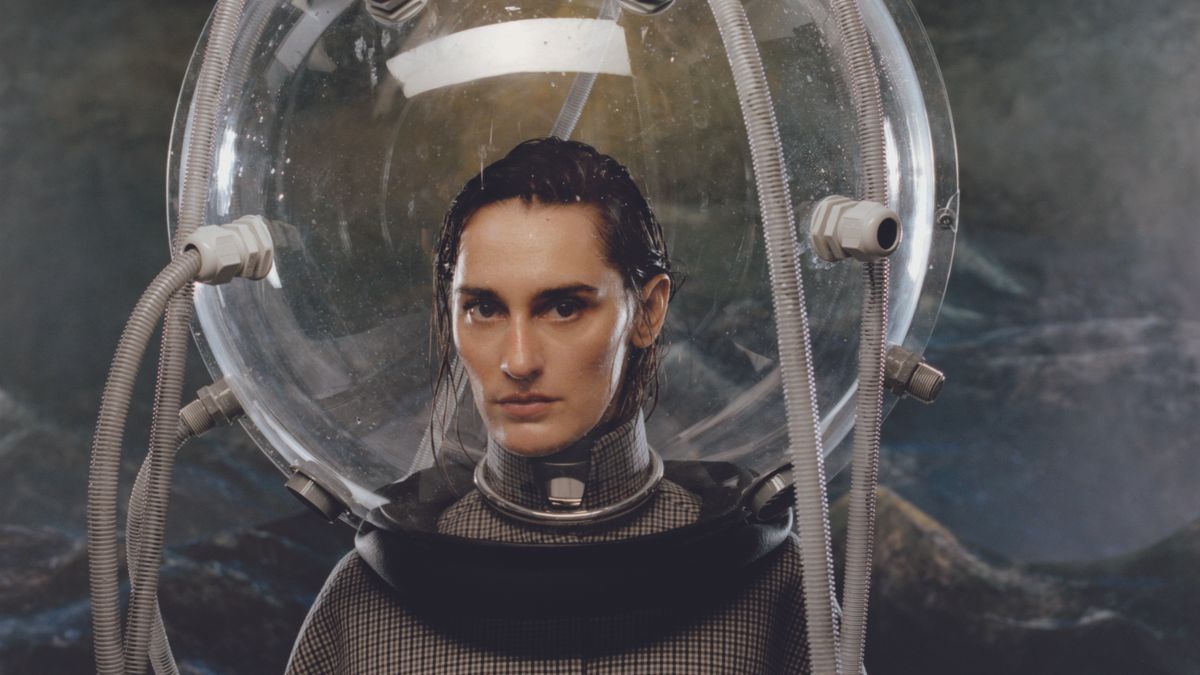
Yelle’s music seems to belong in the city. The dirty synth basslines and clattering electronic rhythms of songs like Karaté or Ba$$in are tailor-made for the neon-soaked streets of LA or Tokyo.
And then there are Julie Budet’s vocals: Madonna meets Francois Hardy in some sleazy, backstreet Parisian bar. Even their videos seem to exude a disturbing, futuristic glamour. Dystopian vignettes with an impish sense of humour and style.
It’s surprising, then, to find the Yelle studio perched atop a lonely clifftop on the Brittany coast. The views are breathtaking, with the vast sea and sky visible from every window.
“This place is very peaceful,” admits Jean-Francois Perrier, the technical half of Yelle. “Earlier this morning, I was walking with my friend and we could hear nothing. Some people need the noise of the city to help them create music, but we prefer silence. I don’t really listen to much music at all, not even when I’m driving. It’s better that I have some space in my head… space for the ideas to happen.”
There’s a common misconception that France’s relationship with dance music begins in 1995 with the release of the Daft Punk single Da Funk. Then, along came Air, St Germain et al, and suddenly everyone was talking about the ‘French touch’.
In truth, the story starts way before Bangalter and de Homem-Christo. As well as the twisted funk-pop of Les Rita Mitsouko and René Roussel in the 80s, French acts had a huge impact on 70s disco. Cerrone, Gibson Brothers, Sheila and B. Devotion, Ottawan, plus synth-heavy grooves from the likes of Space, Droids and (of course!) Jean-Michel Jarre.
Perrier’s own introduction to dance music came via the Beastie Boys. “I was aware of French dance music, but I thought it was boring,” he laughs. “I didn’t get it. I played drums in a rock band and all I cared about was Rage Against the Machine. After I heard the Beastie Boys’ Hello Nasty album [1998], I started make the connection between Rage Against the Machine and dance music.”
Get the MusicRadar Newsletter
Want all the hottest music and gear news, reviews, deals, features and more, direct to your inbox? Sign up here.
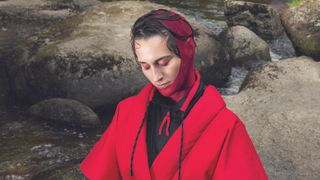
For singer Budet, music runs in the family. Her father had a minor French hit in the '60s and her earliest memories are of going to see him play live. “I was surrounded by music. There were lots of instruments in the house and different singers staying with my father. There was always music on the radio or someone playing records. The house had a lot of soul.”
Budet and Perrier have been a couple for almost 20 years, but only started making music around 2005. An early demo found its way to EMI and, much to their surprise, they were offered a deal. “We didn’t tell them that we only had three songs,” admits Perrier.
Despite singing exclusively in French, Yelle’s music quickly found its way over to America and to the rest of Europe - notably, all three of their previous albums have made the Top Ten in the US Dance charts.
The latest album, L’Ère du Verseau was released in 2020, and includes the singles Karaté and - arguably one of the most beautiful songs of the year - Je T’aime Encore.
The couple live together, but Perrier - over Skype - handles most questions, occasionally checking a name or detail with Budet.
“There are times in the studio where I spend two days moving hi-hats and snares to get a beat to sound human and I think Julie doesn’t enjoy it too much. Like most normal people, she would rather be downstairs sleeping!”
You live together, you’re a couple and you spend most of your time making music together… has that ever come to cause you any problems?
Jean-Francois Perrier: “Not too much. The only time there is tension is when we are recording vocals. I have a strong idea of how I want the words to sound, but Julie is the singer and she also knows how she wants to create the vocal. In the past, it was a battle, but we found a solution. When it’s time for the vocals, I leave the studio and we have a friend who looks after the production. It’s much better for everyone!”
Rhythm is a key component of most Yelle songs. Presumably, that comes from your days as a drummer?
J-FP: “Drums was the first instrument I fell in love with as a kid. Even if I saw a band on a TV show, I was fascinated by the power they gave to a song… the big cymbals. Eventually, I managed to find a pair of sticks and started playing on some containers and pillows in my bedroom.
"My parents realised this was something I cared about and arranged for some lessons with this old guy, a blind drummer. All he had was a kick and snare, but that’s where I really learned to engage my ears. To work out how the drums can assist a piece of music.
“I joined my first rock band when I was 11, but for the next six or seven years, I really concentrated on my technique. I wanted to understand how rhythm worked. I studied Latin and bossa nova, African rhythms. I would dance around the room, playing a rhythm with my arms and legs. What does this beat need? Where are the ghost snares? I would build the rhythm in my head, then play it.
“Around the time I was listening to the Beastie Boys, I also got my first electronic kit, a Yamaha DTX. Again, this was pushing me a bit closer to dance music because of the different sound of the drums.
"The big change was when I got a cheap PC and a copy of Acid. I was like, ‘Oh, my God!’ Chopping up samples and building rhythms on the screen. I don’t know if I was any good, but it felt so easy for me.
“For many years, I didn’t care about chords or melodies. I just wanted to build a beat that would make people dance.”
When you first started working with Julie, did you have an idea of what kind of music you were going to make?
J-FP: “It would be electronic dance music, for sure. And I knew that Julie’s vocals would give the music a lot of character. We were together for maybe two or three years before we started Yelle, and I was always fascinated by the way Julie used to sing around the house. It was as if she was standing on a theatrical stage. She would act out the words… it was very dramatic. I started to imagine music that I could put with her vocals. If she sang, ‘Bah-da-pap-pap’, I would blend an imaginary rhythm and bassline.
“We put together our first demo, Je Veux Te Voir ,and placed it on Myspace. We were encouraged because we had some people listening to us and that’s when we met the guy from EMI. It was like a fairy tale.”
HARDWARE
Apple MacBook Pro
UAD Arrow
Focal CMS65
Korg MicroKorg
Nord Lead synth
Korg Electribe
Yamaha CP-80
Roland Juno 2
SOFTWARE
Apple Logic X
Xfer Serum
Logic Sculpture
Logic ES2
Logic Ultrabeat
Arturia Analog Lab
Soundtoys: EchoBoy, Microshift, Radiator
Logic Flanger
Waves CLA Vox
What was the setup for those early songs?
J-FP: “My cheap PC, Acid, WaveLab for handling the samples, some cheap guitars and the blue Korg Electribe groovebox and synth. I also had an Akai MPC2000, which I was told had a fantastic sound, but I much preferred working in the computer. It was cheaper, too. I couldn’t afford lots of synthesisers, but with Acid and WaveLab, I could build up lots of synth samples from the Electribe.
“I have never been a geek when it comes to studio gear. I don’t know all the latest software and I hate spending lots of time messing around with a new piece of equipment. I prefer a setup that allows me to write songs very quickly. Once we have a good song, then I can start worrying about the details - layering the kick drum and bassline, changing the sound of a synth, adding a little swing to the rhythm.”
You never allow the computer to swing the beat?
J-FP: “No, never! I started doing it by hand in the early days and it is now part of who I am. I go through every beat of the rhythm and adjust where it is and how loud it is. People used to tell me that I should use a compressor to control the dynamics, but I didn’t know how to. That’s where my history with the drum kit is useful. I would make little changes until it sounded like I was playing it myself. And it’s worked much better for us because it also means you keep a human dynamic.”
Are you still with Acid? It seems to be one of those DAWs that has a loyal following.
J-FP: “The MIDI side of things was always a bit of a nightmare with Acid. I did look at Ableton in the early days, but it was just a bit too similar to Acid. A friend of mine was working on Logic and it offered everything I needed. It had a nice look, too… very professional.
“For plugins, I use a lot of Waves and a lot of Soundtoys. Valhalla for reverbs. Serum and some of the Arturia models for synths. I like the Logic plugins, too.
“I use Sculpture for bass and the flanger on my snares, just to add a little bit of movement. Today’s plugins sound so good! When I listen to the EchoBoy, I am amazed at how warm it sounds. How do they do it? Even the basic presets sound incredible.
“At the beginning, I wasn’t so confident about using delay and reverbs. But, in 2010, when we were working on the Safari Disco Club album, I was fortunate to have some advice from Phillipe Zdar [the former member of Cassius who sadly died last year].
“At the time, my mixing technique was all about left and right. I was only thinking in stereo. Philippe said, ‘Why not introduce a third dimension into the music?’ He explained his theory of using three levels of delay and reverb to help you place elements in the room. Let’s say that you have lots of different tracks and the mix is not sounding so clean. Normally, if there are instruments that interfere with each other, you use the stereo field and frequency to give them some space.
“But why not use distance to move them away from each other? The snare and the vocal both use the same frequency, so, keep the snare very dry and add a longer reverb/delay to the voice. You have left and right, but you also have some distance.”
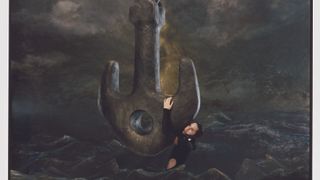
Does that mean that you spend a lot of time mixing on headphones? Gauging your three dimensions?
J-FP: “For the voice, yes. But that is more for comp-ing the vocals… making sure everything is clean and tidy. For the rest, I trust my speakers, Focal CMS65s. I recently bought a pair of Barefoot Footprint 01s and I decided to send them back because I was so used to my Focals. They sound more coherent.
“Actually, I do have one concern with the Focals and that is with the sub frequencies. The middle and the top is OK, but I sometimes get confused with the subs. That’s why we still send the tracks out to be mastered. I prefer to let Mike Marsh at the Exchange work on them. He’s a genius!”
Is the final mix a long process?
J-FP: “No. I’m not one of those producers who will change everything at the last moment. By the time I get to the final mix, everything is kind of in the right place. The only advice I could offer when it comes to mixing is make sure you have a nap.
“There have been times when something is not quite right, but I can’t work out what it is. If you’ve been mixing for several hours, you might not be in a good place, so, take a break. Go downstairs, have a cup of tea. Have a sleep for 20 minutes. As soon as you go back to the studio, the answer will become clear.”
When it comes to songwriting, is it a collaborative process? Julie works on lyrics; you work on the music?
J-FP: “Not always. In fact, there is no single blueprint for a song. It happens in many different ways. Sometimes, I am in my car and one sentence comes into my head. Just a sentence… but I like the feel of the words. Julie sometimes starts with a single word, just because she likes how it sounds. Then with the recent single, Je t’aime Encore, we had some music and Julie wrote the lyrics in 10 minutes. So fast! As if she was writing a letter.
“I do like to work with beats, as well. If I’m not in the studio, I sing the beat into my phone, but if I’m at the studio, I play it on the drum kit, again, recorded with my phone. I like the sound of the compression you get. It’s very dirty and powerful.
"I have tried recording my drum kit properly. You know… with all the mic placement and everything. But it always sounded shit! I put it next to a sampled kick and the choice was easy. The phone loops become extra bits of percussion… maybe a hat pattern to add some life. You can hear that on the track, Noir, from the new album.”
Despite only having two or three band members on stage [in recent years, they’ve been joined by Franck Richard] your live shows are full of movement and musical twists. What gear have you actually got up there with you?
J-FP: “For a long time, we toured as the Yelle Club Party, which was Franck on drums and percussion, me on computer and CDJs, with Julie singing. Then, we moved to me and Franck both playing drum kits, which was much more exciting… very visual.
“And the visuals have really become just as important to the live shows as the music is to them. The computer is now linked up to the light show, and then Julie will have all of her costume changes.
“There is an idea for the future where we have Franck playing just a kick and snare with drumsticks, and the keyboards fixed to a wall at the back. That way, people can really start to see what’s happening.
“As well as hearing the songs, I want the audience to see them. OK, we are not a full live band with 10 people on stage, but we still want to entertain the audience.”
The latest Yelle album, L’Ère du Verseau, is out now on the Recreation Center label.
Vocalist Julie Budet on the importance of singing in French
“In France, we do have a strong singing tradition, with people like Edith Piaf and Francois Hardy, but I was also influenced by English-speaking singers… Madonna, Kate Bush. I was always interested in singers who were more than singers. They can really be inside the song. When they sing, they are singing from the heart. And the only way I could do that was if I was singing in French. To have the lyrics become part of me, they had to be in my own language.
“People always ask if French is an easy language to sing in. For me, of course! I try to create movement and percussion with my voice. But I think that is the same with any language. When I listen to my favourite English singers – Kate Bush is a good example – she does so much with her voice. When she is up on stage, she is not just singing the lyrics. She is performing. She is acting. She is telling a story. I hope I can do the same.”


Computer Music magazine is the world’s best selling publication dedicated solely to making great music with your Mac or PC computer. Each issue it brings its lucky readers the best in cutting-edge tutorials, need-to-know, expert software reviews and even all the tools you actually need to make great music today, courtesy of our legendary CM Plugin Suite.

"A classic compressor for free on Valentine's Day – it must be love!": Universal Audio is giving away an 1176 plugin as a Valentine's gift - here's how to get it and use it
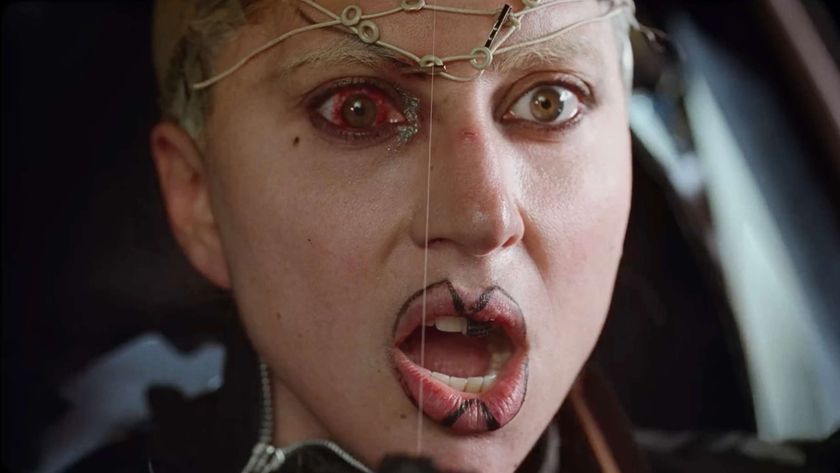
“A magical part is this sidechain with the bass”: Lady Gaga breaks down Disease in new studio video






